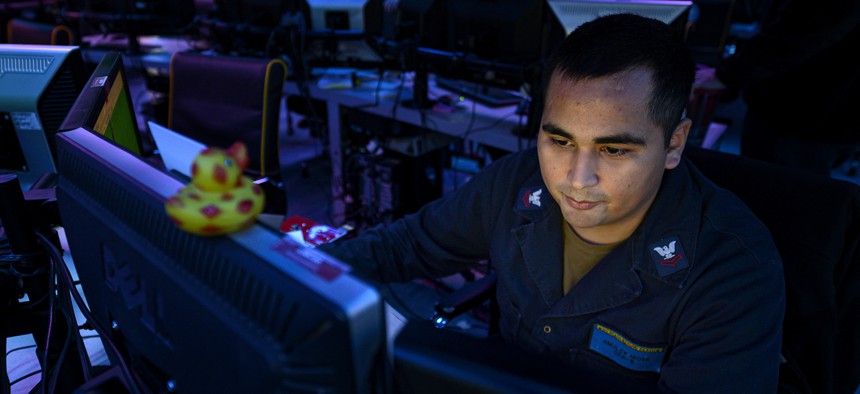
RED SEA (Aug. 25, 2019) Operations Specialist 2nd Class Amulek Moya, assigned to Amphibious Squadron (CPR) 5, stands watch inside the joint operations center aboard amphibious assault ship USS Boxer (LHD 4) during exercise Eager Lion 2019. U.S. Navy photo by Mass Communication Specialist 3rd Class Alexander C. Kubitza/Released
Pentagon Begins ‘Continuous Vetting’ of All Troops for Insider Threats, Extremism; Social Media May Come Next
Automatic alerts will flag records or activities of concern among all Defense Department personnel.
All Defense Department personnel are now subject to “continuous vetting” designed to spot extremists and other insider threats, with surveillance of their public social-media postings likely coming soon, Pentagon officials said Tuesday.
The announcement follows years of effort to comply with a 2011 executive order to improve on the current security-clearance process, which features an initial investigation but generally no followup for five or more years. The new system will raise flags when new information arrives, such as when a DOD employee is arrested.
It arrives as the department grapples with extremism among uniformed and civilian personnel. Conservatives have accused the Biden administration and senior U.S. military leaders of purging right-wing free speech.
Screening troops’ and DOD employees’ social-media posts for extremist views or behavior will become part of the vetting, said William K. Lietzau, who has led the Defense Counterintelligence and Security Agency since March 2020. Lietzau said several pilot programs are intended to help determine how useful it might be to track social-media activity in various ways.
“Whether it's an event-driven look at social media, whether it's a regular continuous look at some social media or whether it's a, a one-time — when they're investigated — look at social media, there's different ways you could use some of the social media, search capabilities that are out there,” he said. “We're still right now analyzing how much value we think there is.”
The department has been working to implement continuous vetting for years, as mandated almost a decade ago by executive order, following shootings at Fort Hood and Army Pfc. Bradley (now Chelsea) Manning’s 2010 arrest for passing top-secret files to Wikileaks.
The department still faces big questions about what data is useful for what outcome. Some records, such as an arrest report or an internal report from a separate security agency, lend themselves to swift action. In January, the agency received an alert that a particular person was under investigation for ties to a terrorist group. Lietzau highlighted the alert as an example of what continuous vetting would allow the Department to do, and when asked, said the individual was not flagged as part of the investigation into the Jan. 6 Capitol attack.
But social media postings, even those that hint at an indication toward violence or anti-government action, are much more difficult to analyze since any threat is much more likely to be hyperbolic than literal. Lietzau said that’s part of the reason why the Defense Department wants to bring in more data continuously to fill out the picture before taking action.
Lietzau said the department is using contractors as a part of various pilot projects to help determine how to incorporate more information into that evaluation process. But DOD officials will retain the ultimate decision of what to do when specific cases or items of concern pop up.
Tara Copp contributed to this story
